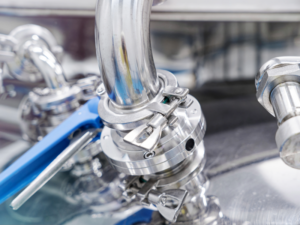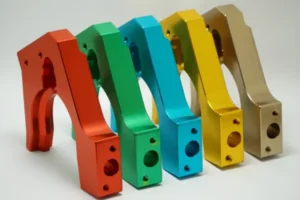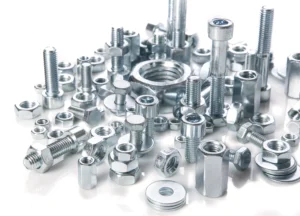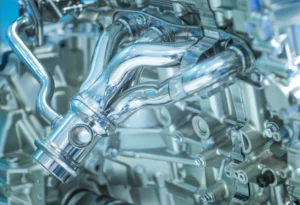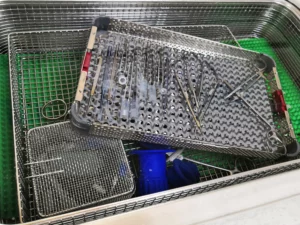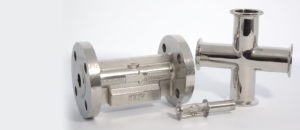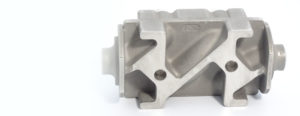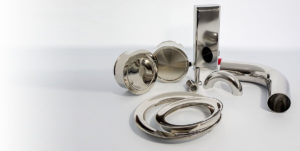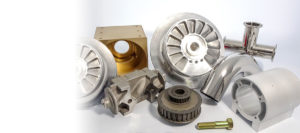Electropolishing Stainless Steel: How it Works –
Electropolishing is a specialized electrochemical process primarily targeting materials like stainless steel. At first glance, it might seem akin to electroplating. However, it operates on an anodic mechanism, making it essentially the opposite of electroplating.
During electropolishing, metal is selectively eliminated from a part under specific conditions such as temperature, current intensity (amperes), and duration. This process focuses on microscopic high points on the metal surface, removing them faster than the lower points. This selective removal creates a more uniform, smoother surface as the material is stripped away.
These peaks and valleys on the metal surface are referred to as micro and macro projections and depressions. When a current is introduced, it results in a polarized film on the part’s surface. This polarization allows metal ions to move through the film. The regions with higher current density, like peaks and burrs, dissolve faster, paving the way for a leveled, burr-free, and smoother surface. This also results in the enhancement of the metal’s brightness, giving it the characteristic anodic luster.
The quality and finish of the surface before electropolishing play a significant role in determining the final surface finish. Adjusting the time, temperature, and current density impacts the amount of metal that gets removed, especially from the high current density regions, leading to an even brighter finish. Manufacturers, especially those with strict dimensional tolerances, should be cognizant of these intricate details.
The chemical reactions during electropolishing result in the cathode releasing hydrogen and the anode emitting oxygen. This process leaves behind a transparent chromium oxide film on the metal’s surface. This film plays a crucial role in partial passivation, enhancing the metal’s resistance to corrosion. Notably, unlike plating processes, electropolishing does not suffer from hydrogen embrittlement, which can render materials brittle. However, if complete passivation is a requirement, it must be pursued as a separate step post-electropolishing.
Advantages of Electropolishing Stainless Steel & Other Materials
Pristine Surface: Electropolishing bestows metal surfaces with a smooth and consistent finish that’s devoid of any imperfections. Such microscopic smoothness reduces the chances of contamination, making cleaning, sterilization, and maintenance much more effective.
Enhanced Corrosion Resistance: Electropolishing ensures the removal of embedded contaminants, enabling the formation of a more consistent and thicker oxide layer. This layer dramatically enhances the metal’s corrosion resistance.
Superior Appearance: One of the most discernible benefits of electropolishing is the heightened surface brightness it offers, often referred to as anodic luster. It’s a non-abrasive procedure, ensuring no directional marks or lines, and presents the metal’s true color.
Applications Across Diverse Metals
While stainless steel is frequently associated with electropolishing, this process is also compatible with other metal alloys such as aluminum, copper, titanium, and even precious metals. Notably, electropolishing acts as an effective pre-treatment for metals like aluminum and copper before undergoing processes like anodizing or plating.
Electropolishing Titanium
Titanium’s inherent qualities like its lightweight nature, high tensile strength, resistance to corrosion, and ability to endure high temperatures make it invaluable for aerospace and medical industries. Through electropolishing, titanium components are rid of microscopic imperfections, contaminants, and debris, enhancing their longevity, corrosion resistance, and biocompatibility.
Sanitary Applications of Electropolished Stainless Steel
Stainless steel, given its non-toxicity and resilience against moisture, organic compounds, acids, and bases, is ideal for industries with stringent sanitary requirements such as biotechnology, cosmetics, food and beverage processing, and life sciences. By electropolishing stainless steel, its ability to resist corrosion is heightened, and the surfaces can be cleaned more effectively with sterilizing agents.
Trustworthy Electropolishing Services
Electropolishing is often the culminating step in a series of manufacturing processes. Given the investments in terms of time and money, it’s vital to rely on experts in the field. With ISO 9001:2000 certification and over 40 years of unparalleled experience, AMF Technologies is a trusted partner for all electropolishing needs, catering to industries ranging from medical to biotechnology and pharmaceuticals.
Specifying for Electropolishing Stainless Steel and Other Metals
Electropolishing stands out as a transformative technique to refine surface finish and enhance corrosion resistance. In turn, this ensures metal components operate at peak efficiency and exhibit increased longevity. For manufacturers and engineers, presenting detailed specifications for their parts becomes imperative.
The key aspects of specifying electropolishing:
1. Material Removal and Desired Surface Finish
Before entrusting a component for electropolishing, manufacturers and engineers must gauge the maximum amount of surface material that can be safely eliminated without undermining the component’s core function. This determination is contingent upon several factors:
- The component’s specific application
- Size tolerances
- Alloy characteristics
In some scenarios, the permissible material removal is exceptionally minimal—often as restrained as .0001” per surface—and must rigorously adhere to predefined size brackets.
It’s vital to have a process that can meticulously manage tolerances up to +/- .0001” per surface. Equally crucial is for your specifications to vividly project the envisaged finish of the component. Through a structured and flexible approach, the desired surface finish is meticulously achieved, aligning perfectly with your specifications.
2. Fixturing Location and Critical Areas
Deciphering the pivotal regions of a component can provide insights into appropriate fixturing. During the electropolishing process, components are secured on bespoke racks and immersed in an electrolytic solution.
Certain components, particularly those necessitating sharp edges, demand meticulous attention regarding fixture positioning. For instance, components requiring razor-sharp edges can be positioned in a manner that guarantees optimal outcomes.
For components where aesthetics play a pivotal role, marking out critical zones can mitigate the appearance of conspicuous fixture markings. The sample electropolishing process offers valuable insights on optimal fixturing locations.
3. Industry or Company-specific Specs
Organizations equipped with pre-established electropolishing procedures usually rely on either industry-standard or proprietary specifications. When soliciting a quote, these standards should be integrated to guarantee the electropolishing provider can meet the stipulated specifications and deliver the requisite finishing outcomes. Among the myriad of guidelines, ASTM B912 emerges as the predominant electropolishing specification. While such guidelines are generally non-specific to components, they serve as crucial benchmarks for processing.
4. Packaging Considerations
Packaging is instrumental in safeguarding the pristine finish of your components. A seasoned electropolishing team, like the one at AMF Technologies, possesses extensive expertise to guide you through achieving superior finishing results from inception to culmination, inclusive of advisory services on optimal packaging solutions. Our promise of “Quality in Metal from Start to Finish” ensures that end results, encompassing packaging, are integrated into specifications from the preliminary phase through to the final results. Highlighting final packaging prerequisites on electropolished component drawings ensures the components reach their destination unscathed, meeting, and exceeding client anticipations.
Electropolishing with AMF Technologies
Electropolishing transcends merely being a process—it’s a meticulous science often positioned as the concluding step in a plethora of manufacturing sequences. As a result, significant time and resources hinge on its success. At AMF Technologies, with an illustrious track record spanning over 40 years and the revered ISO 9001:2000 certification, we are uniquely positioned to cater to your diverse electropolishing needs. Entrust us with your medical components, biotech, pharmaceutical applications, and beyond, for an unparalleled finish and precision. Contact us with any questions you may have or for a quote.

